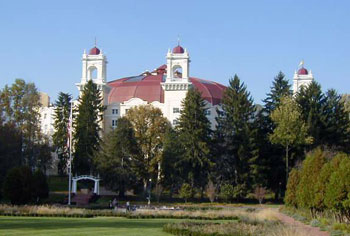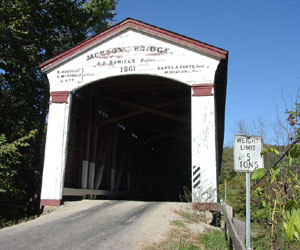Wabash College students from outside Indiana’s borders have never tasted a breaded pork tenderloin sandwich. Many members of the Wabash faculty haven’t ever seen a livestock show at a county fair. Almost no Wabash students realize Parke County is home to more covered bridges than the famed "Madison County." Virtually no member of the Wabash community knows the history of New Harmony, Indiana, Dillinger’s Woods, or why socialites and celebrities from around the world came to French Lick after the turn of the last century.
That’s about to change.
Thanks to a $1 million grant from Lilly Endowment Inc., Wabash College will allow students, faculty, and staff to experience the state of Indiana unlike ever before. The grant comes from Lilly’s Initiative to Recruit and Retain Intellectual Capital for Indiana Higher Education Institutions. Wabash’s creative approach, dubbed Quality of Life in Indiana, will help the college community experience and understand Indiana’s rich culture.
 One part of Wabash’s grant will fund weekly trips around the state to cultural events, and will bring Indiana artists and scholars to campus. History students may visit French Lick or the State Museum; philosophy and religion students are likely to travel to New Harmony or to the Amish and Mennonite settlements at Nappanee; art students can take trips to see the work of Hoosier School artists like T.C. Steele and J. Ottis Adams; and economics students could see the economic impact of the Covered Bridge Festival in Parke County or visit revitalized small towns like Madison, Indiana.
One part of Wabash’s grant will fund weekly trips around the state to cultural events, and will bring Indiana artists and scholars to campus. History students may visit French Lick or the State Museum; philosophy and religion students are likely to travel to New Harmony or to the Amish and Mennonite settlements at Nappanee; art students can take trips to see the work of Hoosier School artists like T.C. Steele and J. Ottis Adams; and economics students could see the economic impact of the Covered Bridge Festival in Parke County or visit revitalized small towns like Madison, Indiana.
"This approach takes advantage of our independence and the Endowment’s willingness to allow us to take a non-traditional approach to attracting intellectual capital to Indiana," says Mauri Ditzler, Dean of the College at Wabash. "This is an educational grant to remind all of us that every place and every people have a culture and there is a richness to it—intellectual, artistic, and religious, for example—that can be easily overlooked because it’s close by or in front of us all the time."
Potential students and faculty from outside Indiana often fail to give Indiana a chance, Ditzler suggests. They see it as agricultural or industrial and not a place with rich history and resources.
The grant will allow Wabash to look closely at Indiana’s culture. Ditzler says it will help students and faculty better understand an Indiana way of life; the way Hoosiers engage issues and solve problems.
Wabash’s four-year program has thee parts: Experience Indiana, Know Indiana, and Present Indiana. It’s Ditzler’s hope that members of the Wabash community will move from doubters to consumers of local culture; then from consumers of the culture to experts on life in Indiana; and finally, from knowledgeable specialists to advocates for Hoosier culture.
When recruiting students to Wabash, College officials rely on current students to be advocates. "Students see the all-male environment as an asset," says Ditzler, "and they tell prospective students just that. What we hope is that they’ll also sell Crawfordsville, Montgomery County, and all of Indiana as a similar asset in their intellectual development."
 Ditzler hopes that by traveling the state with students to learn more about Indiana—tasting its food, attending its festival, and celebrating its arts culture—that students will want to live their lives here, thus slowing Indiana’s "brain drain." He also hopes the same holds true for faculty who come to Wabash.
Ditzler hopes that by traveling the state with students to learn more about Indiana—tasting its food, attending its festival, and celebrating its arts culture—that students will want to live their lives here, thus slowing Indiana’s "brain drain." He also hopes the same holds true for faculty who come to Wabash.
"We’ve hired a good number of tenure track faculty in the last eight years," says Ditzler. "I think these young faculty members will lead happier and richer lives if they take the time to understand the state of Indiana. And given the number of our students who are Midwesterners, we especially need to do a better job of understanding their values so that we reinforce the strong aspects of a student’s heritage before teaching them new things.
"A people’s culture is their treasure; their strength and character is shaped by that culture."
Given the richness of Indiana history and culture, the possibilities of Experience Indiana are as boundless as the imagination and enthusiasm of Wabash students and faculty. Travel destinations are limited only by the state’s borders.
"Where we go and what we do are not as important as developing a fundamental understanding and respect for a way of life; for understanding the beauty of Indiana’s natural resources, its agriculture, and the aesthetics of our state," says Ditzler, himself a native Hoosier.
Know Indiana is the more intellectual and educational aspect of the grant, and provides students and faculty opportunities to study a culture that is now local to them. Research grants will be available for faculty who wish to gain a stronger understanding of an aspect of Indiana culture, resources, or people in preparing first-year or upper-level courses.
Know Indiana will also fund course-based excursions to Indiana study sites. Wabash has fully embraced embedding travel into many of its courses, but few immersion trips have taken place in Indiana. Know Indiana will also support student projects, research, and internships within the state.
Ditzler says Present Indiana should produce two distinct outcomes: Wabash will become a community of "enthusiastic epistles" for life in Indiana, and Wabash will create positive impressions for visitors to the state, such as international college students, personnel directors and business leaders, and newly relocated employees of Indiana firms.
"We’re a liberal arts college and we’re counter-intuitive," Ditzler says. "We’re audacious, and we believe in finding ways for small groups of individuals with good ideas to have an enormous impact on society. We certainly can’t solve any of Indiana’s problems by mass; we’re small, and we hope that in our own unique way, we can create positive impressions of Indiana for students, faculty, staff, and visitors."
The "Quality of Life in Indiana" grant will be administered by the Dean of the College and a steering committee, comprising students, faculty, staff, and alumni. A partnership with the Arts Council of Indianapolis will aid in identifying travel destinations. Wabash’s Center for Academic Enrichment will manage the logistics of the grant.
"What would be perfect is if individuals and groups from across Indiana would work with us to identify what some of the most unique and educational aspects are," adds Ditzler. "It would be great if we got calls from all over the state with people on the other end saying, ‘Hey, we’ve got something here your students have to experience.’ When that happens, we’ll feel like we’ve taken a big step."